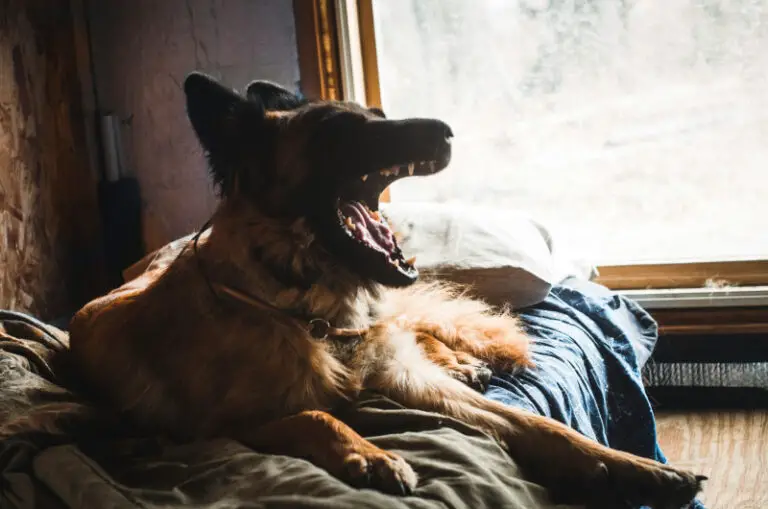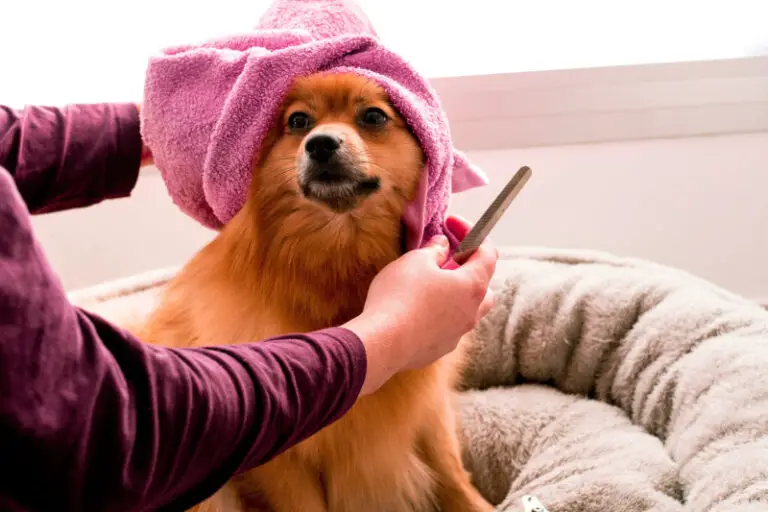Thick, beautiful, shiny fur in dogs is a sign of good nutrition and overall health. Seeing a dog start to lose too much hair, either in parts or all over the body, can be distressing. Does your dog lose its hair and you don’t know why, or what to do to stop it?
Keep reading to learn about the possible causes of canine alopecia, its common symptoms, and available forms of treatment.
Table of Contents
Why do dogs lose their hair?
Hair loss or alopecia in dogs is a common disorder, characterized by partial (patches) or total loss of fur. This can be due to numerous conditions, mainly linked to the endocrine system, lymphatic system, immune system, and the pet’s skin. Canine alopecia can affect dogs of any age or breed.
Although it is not considered a serious condition, abnormal hair loss is still a worrying phenomenon.
The 9 most common causes of hair loss in dogs
First of all, it is important to clarify that the vast majority of dogs lose old hair as a result of seasonal shedding. This fall is completely normal, especially in indoor dogs or those who live in places with very marked seasonal changes. Depending on the breed, shedding can occur 1 or 2 times a year, and last a few weeks.
During the normal shedding process, the dog sheds evenly. The owner will notice that there are no patches left.
Now, when hair loss cannot be associated with seasonal shedding, is more abundant than usual, or does not occur evenly, then it may indicate that something is wrong.
According to expert sources, these are the causes to consider if your dog loses a lot of hair:
- Bacterial or fungal infections
- Scabies and other parasites
- Allergies
- Malnutrition
- Hormonal fluctuations
- Pressure sores
- Certain diseases
- Stress
- Rashes/hives
Let’s see what characterizes each of these conditions and how you can identify them …
1. Bacterial or fungal infections
The skin and coat of dogs often harbor different bacteria and fungi. Normally this does not cause problems; however, sometimes pathogens can proliferate and end up creating an infection. Both fungal and bacterial infections cause redness, itching, pustules, a bad odor, and abnormal hair loss.
Ringworm, for example, is a very common cause of canine alopecia. A dog with ringworm will present with red, scaly hairless patches, accompanied by a lot of itching.
If you suspect that your dog is losing its hair because it has ringworm or any other infection, go to the vet as soon as possible for a check-up.
2. Scabies and other parasites
Scabies is a general term to refer to skin infections caused by mites. Mites are microscopic creatures that live on the surface of the skin or hair follicles and cause hair loss/itching by penetrating orbiting the skin. The hair can fall out in a circular or irregular shape.
Some mites, like the mange mite, are extremely contagious, not only to dogs but to humans as well.
Added to this are other common parasites, such as fleas and ticks. Some infected dogs are known to bite, lick, and scratch themselves uncontrollably, losing hair in various places. Sagging and swelling are usually seen around the belly, chest, eyes, and ears.
While some minor infections may clear up on their own, serious parasitic infections require special medications.
In addition to skin parasites, internal parasites, for example, intestinal worms, can also cause a dog to lose its hair. These cause poor coat health and further shedding by damaging the animal’s ability to process nutrients.
3. Allergies
Like people, dogs often develop allergies, usually to fleas, food, and environmental irritants (pollen, mold, dust). Although respiratory symptoms may be present, the most common is for an allergic dog to have skin reactions, such as itching, reddened areas, and unusual hair loss.
Cool-weather conditions are said to provide some relief for dogs with seasonal allergies, but those with ingredient or food sensitivities can shed year-round.
4. Malnutrition
Maintaining a proper diet is essential for the health and beauty of the coat in dogs. When your pet’s diet doesn’t provide all the nutrients your body needs, hair loss can be a long-term consequence. This is especially true for growing puppies and sick dogs.
As an owner, be sure to provide a high-quality, balanced diet rich in protein, good fats, and essential vitamins and minerals.
5. Hormonal fluctuations
Changes and imbalances in sex hormone levels can also cause male and female dogs to lose more hair than normal. For example, it is common for a dog to lose a lot of hair during pregnancy and lactation. In that case, the hair follicles enter a resting phase in order to preserve as much energy as possible for the puppies.
Also, some dogs may shed more after being neutered due to decreased testosterone levels.
6. Bedsores
Pressure or decubitus ulcers are a type of skin injury caused by rubbing and repeated pressure in the same place. Older, sick, or overweight dogs are especially prone to this condition. Ulcers often form on the elbows or other bony parts that are in contact with hard surfaces.
Over time, the constant pressure leads to thickening of the skin, alopecia in those areas, and the formation of calluses.
7. Certain diseases
Some metabolic disorders, such as hypothyroidism and Cushing’s disease, can cause a dog to start shedding a lot around the house. Kidney disease, liver disease, and cancer are also associated with unexplained hair loss.
Taking into account that these diseases have other more serious consequences, it is important to consult the veterinarian in case of any suspicion. Unusual shedding, accompanied by lethargy, weakness, lack of appetite, excessive thirst, or other symptoms, requires immediate attention.
8. Stress
Has your dog already been examined by the vet, but everything seems fine? Perhaps he loses too much hair due to stress. Stress and anxiety are known to be triggers for canine alopecia, either on the whole body or on specific parts.
On occasion, sustained stress and severe separation anxiety often manifest through physical symptoms, such as vomiting, diarrhea, compulsive scratching, and licking. Such behavior often causes bald patches.
Consider this explanation if the pet lives in a stressful environment if there have been changes in the family routine, if the dog stays home alone for a long time, etc.
9. Rashes/urticaria
Insect bites and stings, the use of certain medications, contact with potentially poisonous plants and chemicals, and even shampoos can cause some dogs to develop a rash or hives. The resulting inflammation, irritation, and itching could lead to the formation of bald patches on the dog’s coat.
Note. Other causes to consider for hair loss in dogs include aging, breed genetics, post-clipping alopecia, collar/clothing friction, certain medical treatments, and biotin deficiency.
Symptoms associated with hair loss in dogs
Depending on the cause in question, a dog that sheds too much hair may present:
- General thinning of the coat
- Patches of skin without any hair
- Lack of hair around the eyes and mouth
- Itching, inflammation, and redness
- Bad smell
- Black or dark gray skin patches
- Dry and scaly skin areas
- Moisture oozing or bleeding
Almost all dogs shed at some point in the year, but if the coat loses volume to the point of showing skin or the hairs seem to shed too easily, it may be considered an episode of excessive shedding.
What to do so that my dog’s hair does not fall out so much?
The first step in preventing a dog from further shedding is to identify the cause of the problem. Some cases can be solved relatively easily at home, while others require the administration of medical treatment.
Routine Care and maintenance
If the dog is shedding a lot, but this loss is due to normal seasonal shedding, daily brushing, regular bathing with a moisturizing shampoo, and warm air drying is recommended. This helps reduce the amount of hair trapped in the coat and therefore the volume of loose hair inside the home.
Remember: Frequent brushing helps distribute the natural oils that keep the coat shiny and the skin hydrated and protected.
Many owners say that taking the dog to the groomer for a professional clipping and brushing makes a difference at this stage.
Proper nutrition
A change in diet may be all it takes to stop excessive hair loss. If the veterinarian suspects that the alopecia is due to possible nutritional deficiencies, the solution will be to provide a balanced, nutritious diet of the highest quality.
If it is due to a food allergy or intolerance, the introduction of a hypoallergenic food (free of allergens) for dogs is recommended. Common allergens are wheat, corn, soy, and egg.
Specialized shampoos
There are numerous shampoos on the market designed to treat several of the causes involved. This includes anti-flea shampoos, anti-fungal shampoos, moisturizing shampoos, hydrocortisone shampoos, and even anti-hair loss shampoos.
It may interest you: 15+ Best Homemade Anti-Flea Remedies (Dogs, Cats, House)
Medicines
Hair loss in dogs caused by serious infections or underlying diseases requires the initiation of a treatment plan. Among the commonly used medications are antibiotics, antiparasitics, anti-inflammatory ointments, hormonal treatments, etc.
Supplements
Some natural supplements can help restore good skin and coat health, and therefore prevent so much shedding. The vet may suggest supplementation with fish oil, biotin, melatonin, and keratin.



